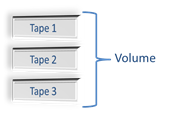The table below lists commonly used tape archiving terms. See the figures after the table for diagrams illustrating these terms.
|
Term |
Description |
|---|---|
|
Autoloader |
A device that has an internal tape changing mechanism as well as one or more drives, which can read from and write to magnetic tape media on more than one tape. This term is also used in Unitrends documentation in reference to autoloaders and tape libraries, which are used in the same way in the Unitrends D2D2T system. |
|
Slot |
A numbered storage bay for a tape inside a tape autoloader/library. |
|
Tape device |
Either a tape drive or tape autoloader. |
|
Tape drive |
A device that reads from and writes to magnetic tape media. Only one tape is loaded into a drive at a time, and it takes several minutes to load each tape. |
|
Volumes |
Archive sets that might be contained within one tape or might span several tapes. |
In this example, the tape in slot 8 is loaded into tape drive 1.

In this example, the volume (archive sets) resides on three tapes.
